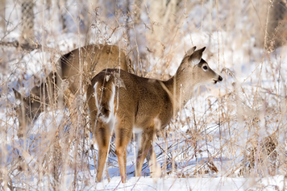These deer would eventually come to be known as White-tailed Deer, for their signature white tail-flagging, displayed as a warning to other members of the herd when fleeing danger. They were a mainstay of the Native American diet and would enable the very survival of the new world’s European colonists. The White-tailed Deer, Odocoileus virginianus, was a welcome sight of sustenance for both the Massachusetts Bay and Virginia colonists. In fact, the deer could be found throughout the Atlantic seaboard and far inland, inhabiting diverse habitats from woodlands to palmetto groves. Like the North American Bison and Passenger Pigeon, it was the deer’s ubiquitous nature that led to its unregulated hunting. Reaching lengths of 7 feet and weights exceeding 200 pounds, the tan colored creature was a large and curious target.  With sustenance hunting to feed a growing nation, Whitetails, as they are commonly called, grew scarce. From pre-colonial numbers of an estimated 30 million animals, their numbers shrank to no more than 30,000 throughout North America. From 1700 to 1900, Connecticut’s herd hovered near complete extirpation, or local extinction. Yet with protection and the regrowth of a clear cut Connecticut, the herd rebounded and recovered strongly with a current population estimated at 90,000 animals. With common occurrence comes common expectations. Yet there is nothing common about the Whitetail’s attributes. Unlike their more habitat-restricted North American cousins: moose, caribou, elk, and black-tailed deer, whose ranges have contracted, Whitetails are generalists who have expanded their pre-colonial range. Today, they range from the Yukon to Panama and inhabit the Lower 48 with the exception of swaths of California, Nevada and Utah. Their adaptability is extraordinary, enabling them to thrive in the deserts of the southwest, the temperate forests of the Great Lakes region and remarkably, even the Florida Keys. A key aspect of their legendary adaptability is their variability, with the largest recorded buck coming from Minnesota at 511 pounds, while the smallest adult Key Deer (a Florida subspecies) tip the scales at just 70 pounds. Such variability in mass allows the deer to conserve or dissipate body heat to suit their environment. This is possible through their genetics and expansive diet which enables these herbivores to subsist on the grasses, leaves, fruit, vegetables, shoots, buds, bark and roots of more than 600 species of plants! Like all deer species other than Reindeer and Caribou, Whitetail females or does, do not grow antlers. Triggered by hormone levels linked to daylight and plant growth, males, known as bucks, grow antlers made of bone during the spring and summer and spar with other males each fall. The bane of many New England gardeners, these Connecticut natives are Fairfield County regulars, adorning the shoulders of the Merritt Parkway year ‘round and vaulting all but the highest garden fences with ease. In fact, it is the White-tail’s speed and agility which has earned it renown. Covering 30 feet in a running bound, clearing 9-foot fences and hitting top speeds of between 35-40 miles per hour, they are among the swiftest members of their clan. Each May or June, does typically give birth to twins but single births and triplets occur frequently. Whitetail fawns are 4-8 pounds at birth and are a rich reddish brown with up to 300 cream colored spots–the perfect camouflage to hide in the leaf-dappled light of the forest floor. The doe will leave them for hours at a time to feed and return briefly to nurse 2-3 times each day. The young grow rapidly–doubling their weight in two weeks! So just how does this seemingly defenseless “abandoned” youngster survive in the unforgiving world of coyotes, bobcats and Black Bears? Mother Nature has equipped these fawns with tremendous adaptations to counter the perils of the forest. Beyond their extraordinary camouflage, the fawns are born with a unique scent which their mother recognizes, yet renders them virtually odorless to carnivores. To accompany the undetectability, fawns instinctively lay still amid grass or leaves even when danger is just feet away. Predators are instinctively hard-wired to chase fleeing prey. Simply put, they just don’t know what to make of something which is hard to see, odorless, and doesn’t run away. If a fawn’s first line defenses don’t do the trick, their next level defenses usually thwart their enemies. A fawn’s rapid weight gain is accompanied by accelerated maturation. These little ones can walk just hours after birth, can outrun us sluggish humans just days later, and can evade all but the swiftest predators within three weeks. In 21st century Fairfield County, we consider the Whitetail a nuisance to motorists and gardeners, a common wild neighbor with a knack for getting in our way. Yet the Whitetail is far more than an occasional nuisance neighbor. These wildly successful creatures are the epitome of adaptability and serve as a model for the recovery of other species facing local or regional extinction. Whitetails are “been there–done that” creatures. From a population of no more than a handful of survivors, they have completely repopulated all available habitat in every city, town and neighborhood of our Nutmeg State. They possess the traits to survive and thrive amidst myriad survival challenges. With such a history of resilience, it would behoove us to look to our neighbors with a respect for their abilities, earned over the centuries. This blog post first appeared in the Greenwich Sentinel on November 20, 2020, as part of their Wildly Successful series by Jim Knox.
0 Comments
Leave a Reply. |
Archives
July 2024
|
Connecticut’s Beardsley Zoo is dedicated to acquainting a diverse public to the delicate balance that exists between living things and their environment.
Connecticut's Beardsley Zoo is a 501(c)(3) not for profit owned and operated by the Connecticut Zoological Society.
Connecticut's Beardsley Zoo is a 501(c)(3) not for profit owned and operated by the Connecticut Zoological Society.
© 2022 Connecticut's Beardsley Zoo


 RSS Feed
RSS Feed





